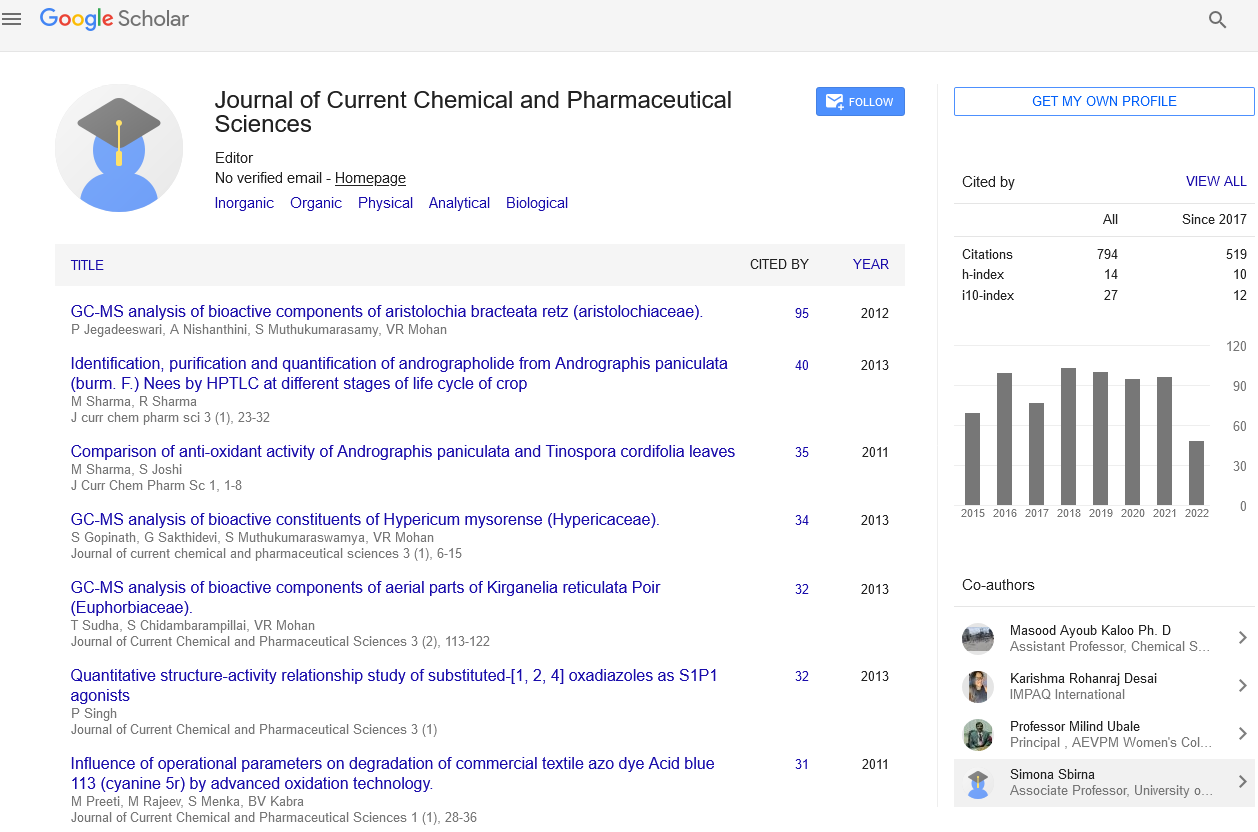Position statement
, Volume: 12( 1)Modeling the Mechanisms and Stabilization of Methionine, Tryptophan and Histidine Oxidation in PTH
- *Correspondence:
- TZ John Department of Pharmaceutical Sciences, St. Vincent University, Victoria, Australia. E-mail: johnt@gmail.com
Received: January 03, 2022, Manuscript No. JCCPS-22-005; Editor assigned: January 05, 2022, PreQC No. JCCPS-22-005 (PQ); Reviewed: January 13, 2022, QC No JCCPS-22-005; Revised: January 21, 2022, Manuscript No. JCCPS-22-005 (R); Published: January 28, 2022, DOI: 10.4172/ JCCPS 2277-2871.005
Citation:John TZ. Modeling the Mechanisms and Stabilization of Methionine, Tryptophan, and Histidine Oxidation in PTH. J Curr Chem Pharm Sc. 2022; 12(1):005
Abstract
Recent oxidation events on monoclonal antibody candidates prompted us to investigate the mechanism of oxidation of Met, Trp, and His residues and to search for suitable stabilizers. By using parathyroid hormone (1–34), PTH, as a model protein and various oxidants, aided by liquid chromatography, peptide mapping, and mass spectrometry, we identified and quantified the oxidation of these vulnerable residues. Whereas H2O2 and t-butyl hydroperoxide (t-BHP) primarily oxidized the two Met residues, 2,2′-azobis(2-amidinopropane) dihydrochloride (AAPH), and H2O2+Fe(II) oxidized Met and Trp residues, with AAPH more capable of generating oxidized Trp species than the latter. H2O2+Fe(III) generated results comparable to those with H2O2+Fe(II), except that there was a lesser amount of hydroxylated Phe.
Keywords:
Oxidation; Hplc; Mass Spectrometry; Free Radicals; Stabilization; Excipients; Pth; Tryptophan; Trolox; Pyridoxine
Description
Recent oxidation events on monoclonal antibody candidates prompted us to investigate the mechanism of oxidation of Met, Trp, and His residues and to search for suitable stabilizers. By using parathyroid hormone (1?34), PTH, as a model protein and various oxidants, aided by liquid chromatography, peptide mapping, and mass spectrometry, we identified and quantified the oxidation of these vulnerable residues. Whereas H2O2 and t-butyl hydroperoxide (t-BHP) primarily oxidized the two Met residues, 2,2?-azobis(2- amidinopropane) dihydrochloride (AAPH), and H2O2+Fe(II) oxidized Met and Trp residues, with AAPH more capable of generating oxidized Trp species than the latter. H2O2+Fe (III) generated results comparable to those with H2O2+Fe(II), except that there was a lesser amount of hydroxylated Phe. Oxidation of the His residue in PTH occurred when copper was used instead of iron. AAPH, a free- radical generator, produced alkyl peroxides, which simulated the oxidizing species from degraded polysorbate, commonly found in protein formulations. It is prudent to screen stabilizers by using H2O2, H2O2+Fe(II), and AAPH because these agents represent potential assaults from the H2O2 commonly present in degraded polysorbate, the residue of aseptic agents and the metal from stainless steel surfaces, and alkyl peroxides from degraded polysorbate, respectively.
Oxidation in Proteins
Oxidation is one of the major chemical degradation pathways for proteins in pharmaceutical products. This topic has been reviewed by Lietal et al. Side chains of Cysteine (Cys), Methionine (Met), Tryptophan (Trp), Histidine (His), and Tyrosine (Tyr) residues are prone to oxidation, in that order. The thiol group in Cys is the most reactive functional group; hence, very few pharmaceutical proteins contain free Cys. In this report, Cys oxidation will not be addressed; instead, we intend to focus on the oxidation of Met, His, and Trp . Another aspect of oxidation, photo-oxidation, will also be excluded from this discussion.
Selection of a Model Protein
PTH was chosen because of its minimal tertiary structure and its sequence, which contains all three desirable amino acids (one Trp, two Met, and three His). Another aspect of oxidation, photo-oxidation, will also be excluded from this discussion.The ease with which it can be assayed by reversed-phase high-performance liquid chromatography.
( HPLC); and its availability. When Chu et al. Studied Met oxidation in PTH stressed only by H2O2, the different oxidation rates of Met8 and Met18 were found to correlate to the 2-shell water coordination number . The difference, <1.5-fold, was not sufficiently significant to influence the conclusion that we would draw from our study. The oxidation rates of different Met residues in growth hormone were attributed primarily to different degrees of solvent exposure. We would expect the oxidation rate of the fully solvent-exposed Met in PTH, growth hormone, and rhVEGF to be comparable. Therefore, the two Met residues on PTH can simulate solvent-exposed Met in all proteins. Ease of analysis by LC/MS because of the presence of only one Trp made PTH a good model protein for our study. One should recognize that the results from PTH cannot fully simulate the oxidation in a complex protein such as a MAb where protein structure exerts influence on the rate and extent of residues.
This study differs from the prior work on PTH in the use of oxidizing conditions. Prior studies employed only hydrogen peroxide whereas the conditions used in this study allowed the Trp and Phe to be oxidized and observed. Met and Trp Oxidation in PTH shows the rp-HPLC chromatograms of PTH reacted with H2O2, in which Met18[O]-PTH, Met8[O]-PTH, and doubly oxidized PTH species were detected; their identities were confirmed by LC/MS. Reaction conditions, pH 5 and 40
